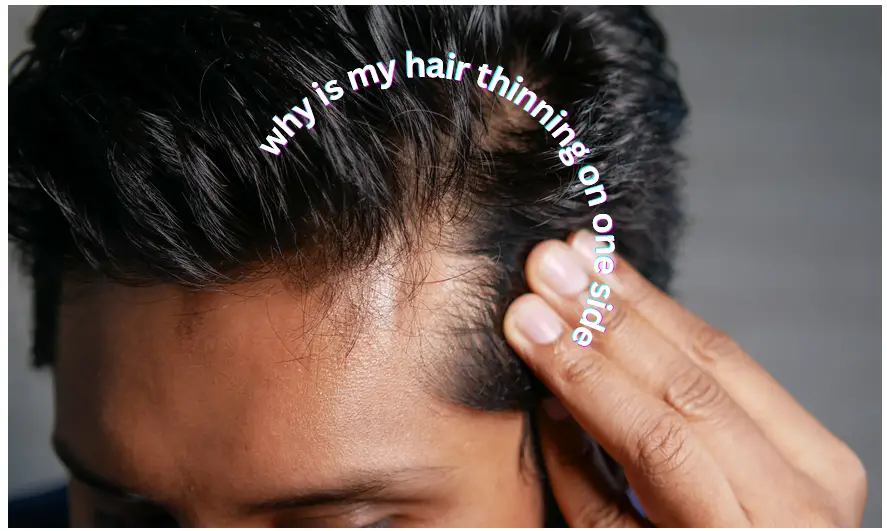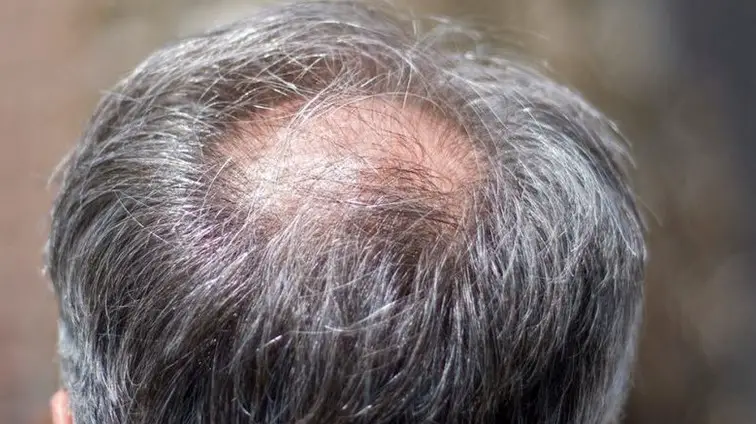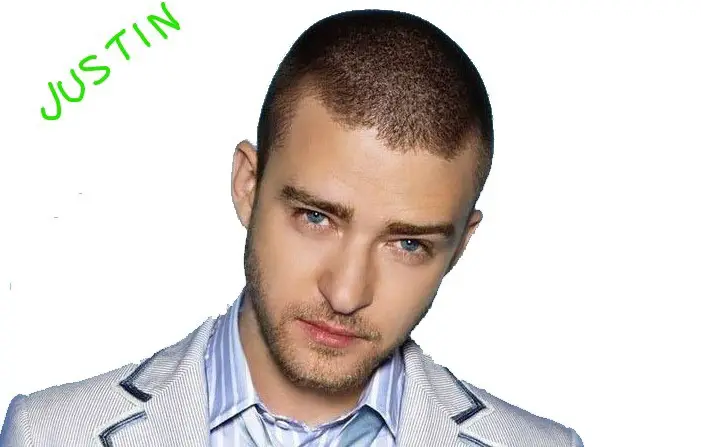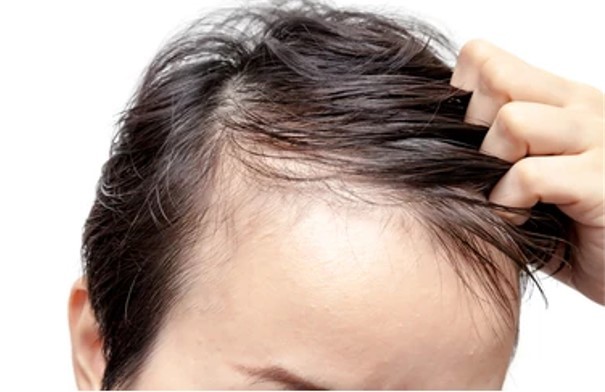Explore our comprehensive guide on ‘hair thinning on sides’, a common hair loss condition. Understand its causes, treatments, and preventive measures. Learn from expert advice and take control of your hair health today.
Hair loss is a common concern for many people, and it can be particularly distressing when it occurs in specific areas like the sides of the head. Hair thinning on sides is a condition that affects both men and women, and understanding its causes and potential treatments is crucial for managing it effectively.
In this comprehensive guide, we’ll delve into the root causes of hair thinning on the sides, explore various treatment options, and provide practical tips to maintain healthy hair. Whether you’re experiencing this issue yourself or know someone who is, this article will equip you with the knowledge you need to tackle hair thinning head-on.
If you’re noticing that your hair is thinning, it’s important to remember that you’re not alone. Many people experience this issue at some point in their lives. In fact, according to the American Academy of Dermatology, millions of men and women deal with some form of hair loss during their lifetime.
Before we delve deeper, let’s clarify what we mean by hair thinning on sides. This term refers to a noticeable reduction in hair density or volume on one or both sides of the head. It can occur due to various reasons, including genetic factors, hormonal imbalances, certain medical conditions, and lifestyle factors.
In the following sections, we’ll explore these causes in more detail and provide actionable advice on how to address them. So, if you’re ready to take control of your hair health, keep reading.
Discover the 7 Signs of Balding at 20 and learn how to spot the early signs of hair loss.
Key takeaways:
- Hair thinning on sides is a common condition that can be caused by various factors, including genetics, hormonal imbalances, certain medical conditions, and lifestyle factors such as stress and poor nutrition.
- There are several treatments available for hair thinning, ranging from medical interventions like medications and hair transplants, to natural remedies and lifestyle changes. The success of these treatments largely depends on the underlying cause of hair thinning.
- Maintaining a healthy lifestyle, including a balanced diet, regular exercise, and adequate sleep, can support overall hair health and potentially prevent hair thinning.
- If you’re experiencing significant hair thinning or if hair loss is causing you distress, it’s important to seek medical advice. A healthcare professional can help identify the cause of hair thinning and recommend appropriate treatments.
- Every person’s experience with hair thinning is unique, and what works for one person might not work for another. It’s all about finding the right approach for you.
Stay tuned as we unravel the mystery behind hair thinning on sides and provide you with a roadmap to healthier, fuller hair.
Related Article: How to Tell if You Have Thinning Hair
What is Hair Thinning on Sides?
Hair thinning on sides is a condition characterized by a noticeable decrease in hair density or volume on one or both sides of the head. It’s a form of localized hair loss that can affect both men and women, and it’s often a source of concern for those experiencing it.
Understanding hair thinning on sides requires a basic knowledge of how hair grows. Our hair grows in cycles, with each hair follicle going through growth, rest, and shedding phases. When these cycles are disrupted, it can lead to hair loss or thinning.
Hair thinning on the sides can manifest in various ways. For some, it might appear as a gradual thinning of hair over time, while others might notice a more sudden loss of hair. It’s also possible to experience hair thinning on one side only, which can be particularly puzzling.
There are several potential causes of hair thinning on the sides, ranging from genetic predisposition to lifestyle factors and underlying health conditions. In the next section, we’ll delve into these causes in more detail to help you understand why this issue might be happening and what you can do about it.
If you’re noticing hair thinning on the sides, it’s important not to panic. While it can be distressing, understanding the potential causes and treatments can empower you to take action and address the issue effectively.
Remember, hair loss is a common issue that many people face. You’re not alone, and there are resources and treatments available to help you.
Learn about the causes of Hair Thinning at Crown in Females and discover how to address this issue effectively.
Related Article: Can Hair Grow Back After Thinning? Explore the potential for hair regrowth after experiencing hair thinning.
Causes of Hair Thinning on Sides
Understanding the causes of hair thinning on sides can help you take proactive steps towards managing this condition. There are several potential causes, ranging from genetic factors to lifestyle habits and underlying health conditions.
Genetics and Hair Thinning
Genetics play a significant role in hair thinning. If your parents or grandparents experienced hair thinning, you might be genetically predisposed to the same condition. This type of hair loss, known as androgenetic alopecia, is the most common cause of hair loss in both men and women.
In men, this condition often manifests as a receding hairline or balding on the top of the head. In women, it typically presents as overall hair thinning, but it can also cause hair thinning on the sides.
While you can’t change your genetics, understanding your family history can help you anticipate potential hair loss and take preventive measures.
Stress and Hair Thinning
Stress is another common cause of hair thinning. When we’re stressed, our bodies produce hormones that can disrupt the hair growth cycle, leading to hair loss or thinning. This type of hair loss, known as telogen effluvium, is usually temporary and resolves once the stress is managed.
If you’ve been under a lot of stress and noticed your hair thinning, it might be worth exploring stress management techniques like meditation, exercise, or talking to a mental health professional.
Discover the root causes of Balding at 20 and learn how stress can contribute to early hair loss.
Illness and Hair Thinning
Certain illnesses and medical conditions can also cause hair thinning. For example, thyroid disorders, autoimmune diseases, and scalp infections can disrupt the hair growth cycle and lead to hair loss.
Additionally, some medications, such as those used for cancer treatment, can cause hair thinning as a side effect. If you’ve recently started a new medication and noticed your hair thinning, it might be worth discussing this with your doctor.
Remember, if you’re experiencing hair thinning, it’s important to seek medical advice. A healthcare professional can help you identify the underlying cause and recommend appropriate treatments.
Related Article: How Long Does It Take to Go Bald? Explore the timeline of hair loss and understand the factors that can influence it.
Impact of Lifestyle on Hair Thinning
Your lifestyle choices can significantly impact the health of your hair. Factors such as diet, sleep patterns, and physical activity can either promote hair growth or contribute to hair thinning. Let’s delve into how these lifestyle factors can affect your hair health.
Diet and Hair Health
Your diet plays a crucial role in maintaining healthy hair. Nutrient deficiencies can disrupt the hair growth cycle and lead to hair thinning. For instance, a lack of protein in your diet can weaken your hair and cause it to thin or fall out. Similarly, deficiencies in vitamins like vitamin D, vitamin E, and B-vitamins can also contribute to hair loss.
To promote healthy hair growth, try to include a variety of nutrient-rich foods in your diet. These might include lean proteins, fruits and vegetables, whole grains, and healthy fats.
Remember, a balanced diet not only benefits your hair but also contributes to your overall health.
Learn about the Telogen Effluvium Diet and how diet can influence hair health.
H3: Sleep Patterns and Hair Health (Word Count: 300)
Sleep is another critical factor in hair health. During sleep, your body repairs and regenerates cells — including the cells that contribute to hair growth. Lack of sleep can disrupt this process and potentially lead to hair thinning.
Aim for 7 to 9 hours of sleep per night to give your body ample time to rest and repair. If you’re having trouble sleeping, consider adopting healthy sleep habits, such as maintaining a regular sleep schedule and creating a restful sleep environment.
Remember, your lifestyle choices can significantly impact your hair health. By adopting a balanced diet and healthy sleep habits, you can help promote healthy hair growth and potentially prevent hair thinning.
Treatments for Hair Thinning on Sides
If you’re experiencing hair thinning on sides, it’s important to know that there are various treatments available. These range from medical treatments to natural remedies and lifestyle changes. Let’s explore these options in more detail.
Medical Treatments
Medical treatments for hair thinning can be highly effective. These treatments often involve medications that promote hair growth or slow down hair loss. For instance, Minoxidil (Rogaine) is a topical medication that can help stimulate hair growth. Finasteride (Propecia) is another medication that can help slow hair loss in men.
It’s important to note that these medications require a prescription and should be used under the guidance of a healthcare professional. They can also have side effects, so it’s crucial to discuss these with your doctor.
If medications aren’t effective, surgical treatments like hair transplants might be an option. However, these procedures can be expensive and may not be suitable for everyone.
Natural Remedies
If you prefer a more natural approach, there are several remedies that might help with hair thinning. These include:
- Scalp massage: Massaging your scalp can stimulate blood flow and promote hair growth.
- Essential oils: Some essential oils for hair growth, like rosemary and peppermint, have been shown to promote hair growth.
- A balanced diet: As mentioned earlier, a diet rich in essential nutrients can support healthy hair growth.
Remember, while these remedies can be helpful, they might not be as effective as medical treatments. It’s always a good idea to discuss these options with a healthcare professional before trying them.
Lifestyle Changes
Finally, making certain lifestyle changes can help manage hair thinning. These might include:
- Reducing stress: High stress levels can contribute to hair loss. Techniques like meditation, yoga, and deep breathing can help manage stress.
- Getting enough sleep: As mentioned earlier, sleep is crucial for cell regeneration, including hair growth cells.
- Regular exercise: Exercise can improve blood flow and promote hair growth.
Remember, while hair thinning can be distressing, there are various treatments and strategies that can help manage this condition. By exploring these options and discussing them with a healthcare professional, you can find a treatment plan that works for you.
Frequently Asked Questions
In this section, we’ll address some of the most frequently asked questions about hair thinning on sides. These questions cover a range of topics, from causes and symptoms to treatments and prevention strategies.
What causes hair thinning on the sides?
Hair thinning on the sides can be caused by a variety of factors, including genetic predisposition, hormonal imbalances, certain medical conditions, and lifestyle factors such as stress and poor nutrition. It’s important to consult with a healthcare professional if you’re experiencing hair thinning to identify the underlying cause and develop an appropriate treatment plan.
Can hair thinning on the sides be reversed?
In some cases, hair thinning on the sides can be reversed or at least slowed down. The success of treatment largely depends on the underlying cause. For instance, if hair thinning is due to a nutritional deficiency or stress, addressing these issues can often lead to improvements.
How can I prevent hair thinning on the sides?
Preventing hair thinning involves maintaining a healthy lifestyle, including a balanced diet, regular exercise, and adequate sleep. It’s also important to manage stress levels and avoid harsh hair treatments that can damage hair follicles. If you’re genetically predisposed to hair thinning, medications might be helpful in preventing or slowing down hair loss.
When should I see a doctor for hair thinning on the sides?
If you’re noticing significant hair thinning or if hair loss is causing you distress, it’s a good idea to see a doctor. A healthcare professional can help identify the cause of hair thinning and recommend appropriate treatments. It’s especially important to seek medical advice if hair thinning is accompanied by other symptoms, such as scalp redness or itching.
Conclusion
Hair thinning on sides can be a distressing experience, but it’s important to remember that you’re not alone. This condition is quite common and can be caused by a variety of factors, including genetics, stress, certain medical conditions, and lifestyle factors.
The good news is that there are many treatments available, from medical interventions to natural remedies and lifestyle changes. By understanding the potential causes of hair thinning and exploring different treatment options, you can take proactive steps towards managing this condition and promoting healthy hair growth.
Remember, if you’re experiencing hair thinning, it’s important to seek medical advice. A healthcare professional can help you identify the underlying cause and recommend appropriate treatments.
Finally, maintaining a healthy lifestyle, including a balanced diet, regular exercise, and adequate sleep, can support overall hair health and potentially prevent hair thinning.
We hope this article has provided you with valuable information and insights on hair thinning on sides. Remember, every person’s experience with hair thinning is unique, and what works for one person might not work for another. It’s all about finding the right approach for you.
Sources:
- Hair Loss Data | American Hair Loss Association
- Understanding Androgenetic Alopecia | National Center for Biotechnology Information
- Exploring the Causes of Alopecia Areata | National Center for Biotechnology Information
- A Comprehensive Review of Telogen Effluvium: Its Causes and Pathogenesis | National Center for Biotechnology Information
- Assessing, Diagnosing, and Managing Trichotillomania: Unraveling the Issue | Nature
- A Unique Case of Pili Multigemini and Rolled Hairs in a Young Woman | National Center for Biotechnology Information
- The Effectiveness of Finasteride 1.25 mg on Female Pattern Hair Loss | National Center for Biotechnology Information
- AI Powered Bald Filter Online 2024: See Yourself with No Hair! - January 19, 2024
- Harklinikken Bad Reviews 2024: Analyzing Negative Feedbacks - January 18, 2024
- How to Get the Alex Eubank Hair | Step-By-Step Tutorial 2024 - January 18, 2024







